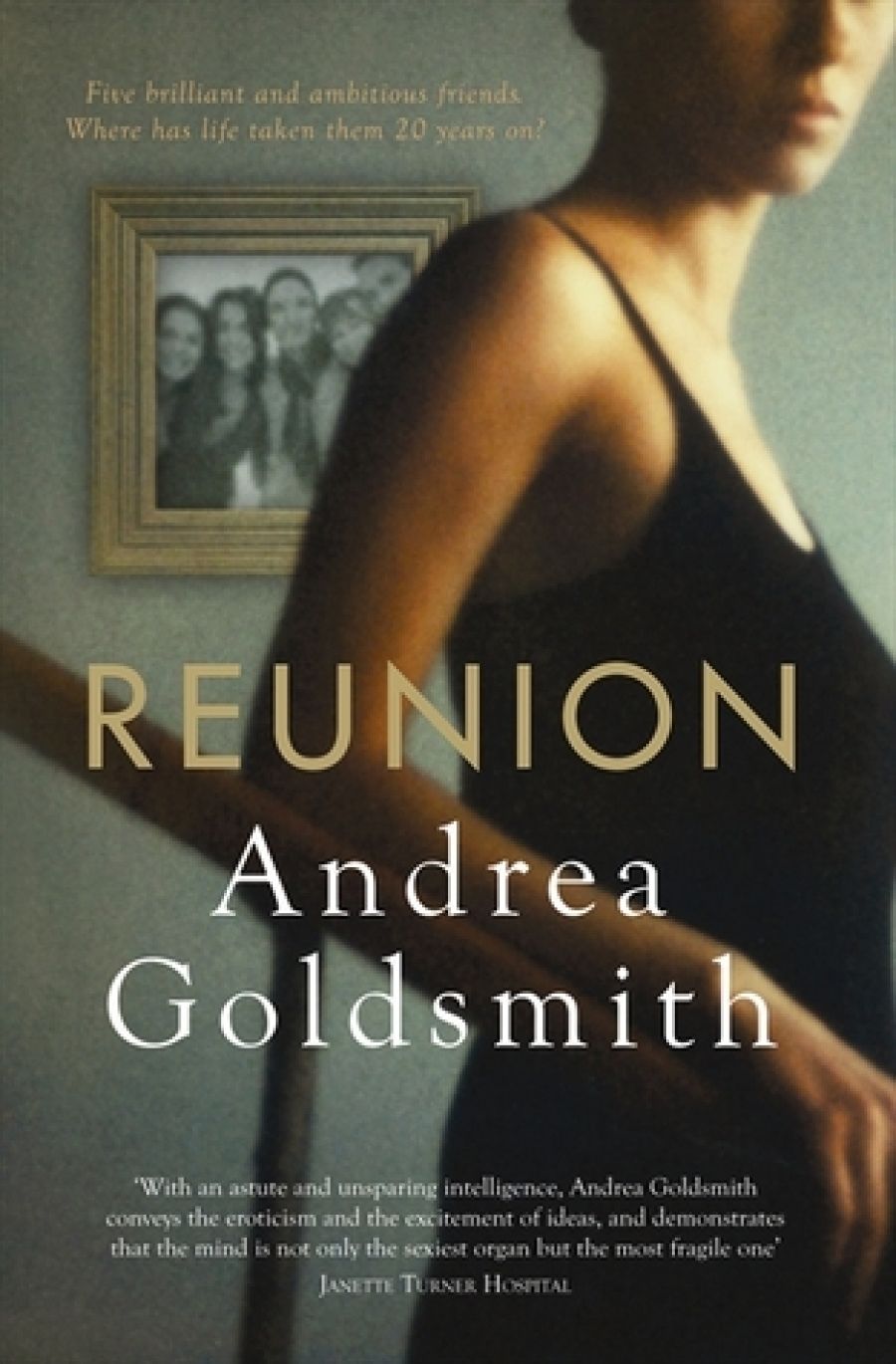
- Free Article: No
- Contents Category: Fiction
- Review Article: Yes
- Online Only: No
- Custom Highlight Text:
What’s the use,’ asks Alice before wandering away from her uncommunicative sister, ‘of a book without pictures or conversations?’ Grown-up readers can probably manage without the former, but it is unusual to find a novel with as little dialogue in it as Andrea Goldsmith’s Reunion, or one that so deliberately ignores the common injunction ‘Show, don’t tell.’
Yet Goldsmith has several books to her credit, including The Prosperous Thief, which was shortlisted for the Miles Franklin Literary Award in 2002, and for several years taught creative writing at Deakin University. Presumably she knows what she is doing. In point of fact, not only does this flouting of conventional rules come over as quite refreshing, it is in any case justified by the demands of the narrative.
- Book 1 Title: Reunion
- Book 1 Biblio: Fourth Estate, $32.95 pb, 416 pp, 97800732287832
The eponymous meeting starts with the reunion of four close, long-standing but dispersed friends. Jack Adelson, a former academic teacher of comparative religion, Ava Bryant, a novelist, and Helen Rankin, a molecular biologist, first met during their undergraduate years at Melbourne University, and maintained their tight-knit friendship as postgraduates at Oxford. The fourth intimate, Conrad ‘Connie’ Lyall, older by fifteen years and once their dashing philosophy lecturer, shared the Oxford years while doing post-doctoral work. The outsider to the group, Harry Guerin, unscholarly and unattractive but a natural entrepreneur, became a quasi-insider through his surprising marriage to the beautiful Ava. After Oxford, the group scatters – to the United States, to New Zealand, and back to Melbourne in the case of Ava and Harry, where the latter has set up the well-financed but not quite credible Network of Global Australians, which, on the occasion of the great reunion has lured the other three home for a short stay. The lure consists basically of grant money, but the ties of affection are also operative.
Before anything can ‘happen’, the reader has to get to know these four people almost as well as they know each other; hence the extended accounts of their respective pasts, not to mention their present situations and future aspirations. Helen, for example, is attracted to a rich scientific post in the United States, but her fifteen-year-old son prefers life in Melbourne; Connie has fallen yet again for a much younger mistress and is anxious to divest himself of his (third) wife, back in Boston. Jack, as always, is captive to hopeless love for Ava, to whom affairs are not entirely foreign, but who remains deeply and genuinely attached to Harry.
This brisk summary, while necessary to a review, is in direct opposition to Goldsmith’s patient, occasionally laborious, but mostly interesting unravelling of the multitude of past experiences that has brought these individuals to the present point in time. Familiarity successfully breeds sympathy and understanding, if to varying degrees. We find ourselves reacting to them as to any group, liking some more than others, finding Jack’s forlorn love, for example, more engrossing than Helen’s somewhat tetchy professional dilemma, but sharing their common impatience with Connie’s fatuous search for his lost youth.
As the past catches up with and merges into the present, the writing comes into flower but retains its essential dependence on the minutiae that have drawn us into these personal but exposed lives. Not only does Goldsmith excel at the interior monologue, she makes us visualise architecture and interiors, feel the variations in the weather, taste the ripeness of a cheese. At the same time, she inserts the textural details into a larger background, be it historical, geographical, political or ideological. The world she builds up in painstaking yet light strokes is entirely convincing, both in novelistic terms and also in its realistic portrayal of Melbourne from the 1970s to the present. A denizen of this city will find the touchstones delightfully authentic; others will see in their mind’s eye a thoroughly convincing and attractive environment, while the contemporary issues the four now have to deal with ring recognisable bells. Helen worries that her scientific research will be misappropriated and used for morally unacceptable goals. Connie has to face the fact that he is not in tune with the requirements of modern television – as a presenter, his stock-in-trade black polo-neck and belted trousers are just so last century.
Despite a few stylistic glitches – overuse of the phrase ‘if not for’, misplaced Frenchification of the Italian forte, the calling into being of two dollar bills – it adds up to what might be called a rich and broad canvas, the kind of novel you enjoy getting back into. What’s happening now? How is Connie doing in his determination to keep up with the insouciant Sara? Is Jack really ‘over’ his tormented love for Ava? Does Harry feel he is getting his due from these reputedly talented people who were always Ava’s friends more than his? The smallness of the ups and downs does not make the ride dull, but renders all the more shocking the drama of the unexpected tragedy which overtakes one of the four.
It is the kind of disaster that is perfectly imaginable, occurring somewhere, one supposes, almost every day; but however close to reality such events may be, this is a novel, by an author not lacking in experience. Just when we least expected it, three of the group retire to the wings and onto centre-stage comes a figure from the past, an older man who had played a small part in one of the life histories, but whom we never imagined seeing again. His mysterious but necessary appearance provides a significant and dramatic twist which revs up the narrative to the point where this very satisfying read ends with both a bang and a whimper.


Comments powered by CComment